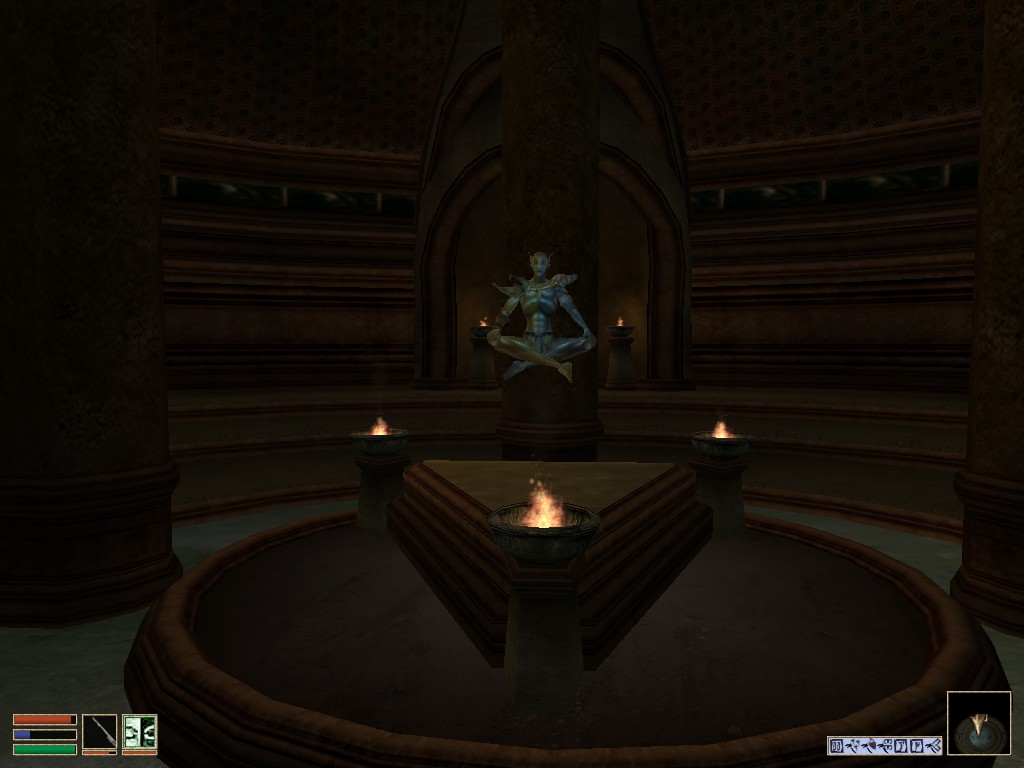The evolution of The Elder Scrolls
How The Elder Scrolls series went from gladiators to Dragonborn.
The Elder Scrolls III: Morrowind (2002)

While Daggerfall followed two years after Arena, Morrowind had six years to ensure its relative sturdiness—the longest development period of any game in the series so far, though that includes a year spent working on one of the spin-offs. That six-year gap also made for the most radical shift in terms of presentation, with the similar interfaces of the first two games replaced entirely. Where they’d had thick bars of buttons hogging the bottom of the screen, Morrowind's HUD is unobtrusive, and while Daggerfall's move to 3D had included an option to mouselook by holding Alt, in Morrowind it's standard. The sensation of presence within its world was radically improved.
That world is also significantly smaller. Bethesda boasted that Daggerfall had “a game world the size of Great Britain”, but Morrowind’s setting only takes up approximately 24 square kilometers. Early in development it was planned for the entire province to be playable, but then its scope was reduced to the single island of Vvardenfell. Likewise, plans to have all five of its Great Houses as joinable factions with their own questlines were scrapped, and their number reduced to three. The payoff for these reductions in size is a setting with a greater degree of interactivity. Daggerfall’s scenery was untouchable, but Morrowind is full of objects that can be picked up and plants that can be harvested. It feels big because there’s so much to do. (And also because fast travel had been removed.)
Rather than being algorithmically generated, Vvardenfell is a hand-crafted place, designed to present stunning vistas. Giant mushrooms, flea-like Silt Striders, floating Netches, buildings hollowed out of the shells of dead behemoths—its overworld is distinctive where Arena and Daggerfall’s had been generic. Its lore builds on Daggerfall’s to add to that distinctiveness, and people have written entire essays about what its hermaphrodite poet god Vivec is really on about.
Still, the actual quests are fairly cut-and-dried with the player cast as another prisoner given a job by the Emperor, this time living up to a prophecy to defeat a dark lord on his dark throne within a volcanic wasteland. It's underpinned by some of the best mythic fantasy writing in videogames, but the quests themselves frequently boil down to traveling to a place and clicking on a person.
Morrowind also made thorough changes to the controls. Movement in the first two games was directed either by left-clicking the edge of the screen you wanted to walk toward (which meant painstakingly centring the screen on objects before picking them up, which made collecting keys from the floor a trial), or by using the arrow keys, with sidesteps bound separately. Morrowind's WASD controls are far simpler, and so is its combat, which no longer requires right-clicking and then dragging across the screen in the direction of your swing. Morrowind’s stealth is activated by crouching, where in Daggerfall it had been an invisible skill check modified by the speed of your movement. With this change playing a thief class suddenly became fun.
Three more classes were also added to the character creation options, as well as Orcs and more beast-like versions of the argonians and khajiit. But one of the most important additions to Morrowind was the Elder Scrolls Construction Set, which not only made it easier for the designers to add new things to the game, like its expansions Bloodmoon and Tribunal, but also for players to do the same. Morrowind was the first game in the series to embrace modding, with over 8,000 mods available for it today. That would turn out to be one of the series’ most enduring changes.
Keep up to date with the most important stories and the best deals, as picked by the PC Gamer team.

Jody's first computer was a Commodore 64, so he remembers having to use a code wheel to play Pool of Radiance. A former music journalist who interviewed everyone from Giorgio Moroder to Trent Reznor, Jody also co-hosted Australia's first radio show about videogames, Zed Games. He's written for Rock Paper Shotgun, The Big Issue, GamesRadar, Zam, Glixel, Five Out of Ten Magazine, and Playboy.com, whose cheques with the bunny logo made for fun conversations at the bank. Jody's first article for PC Gamer was about the audio of Alien Isolation, published in 2015, and since then he's written about why Silent Hill belongs on PC, why Recettear: An Item Shop's Tale is the best fantasy shopkeeper tycoon game, and how weird Lost Ark can get. Jody edited PC Gamer Indie from 2017 to 2018, and he eventually lived up to his promise to play every Warhammer videogame.

